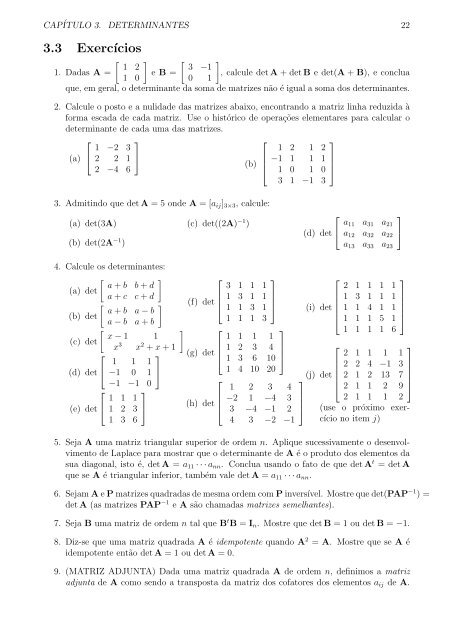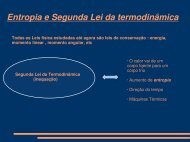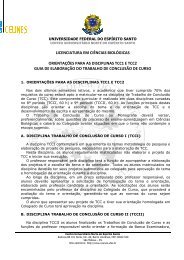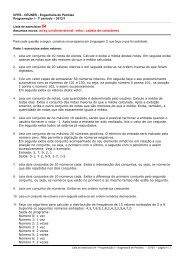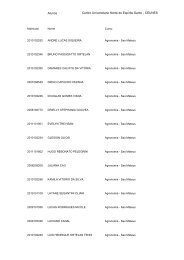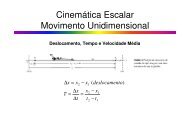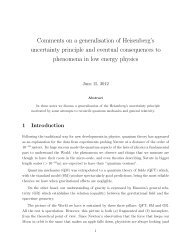ProgramaçËao Linear - Notas de aula - CEUNES
ProgramaçËao Linear - Notas de aula - CEUNES
ProgramaçËao Linear - Notas de aula - CEUNES
You also want an ePaper? Increase the reach of your titles
YUMPU automatically turns print PDFs into web optimized ePapers that Google loves.
CAPÍTULO 3. DETERMINANTES 223.3 Exercícios[ ] [ ]1 23 −11. Dadas A = e B = , calcule <strong>de</strong>t A + <strong>de</strong>t B e <strong>de</strong>t(A + B), e conclua1 00 1que, em geral, o <strong>de</strong>terminante da soma <strong>de</strong> matrizes não é igual a soma dos <strong>de</strong>terminantes.2. Calcule o posto e a nulida<strong>de</strong> das matrizes abaixo, encontrando a matriz linha reduzida àforma escada <strong>de</strong> cada matriz. Use o histórico <strong>de</strong> operações elementares para calcular o<strong>de</strong>terminante <strong>de</strong> cada uma das matrizes.(a)⎡⎣1 −2 32 2 12 −4 6⎤⎦(b)⎡⎢⎣1 2 1 2−1 1 1 11 0 1 03 1 −1 3⎤⎥⎦3. Admitindo que <strong>de</strong>t A = 5 on<strong>de</strong> A = [a ij ] 3×3 , calcule:(a) <strong>de</strong>t(3A)(c) <strong>de</strong>t((2A) −1 )(b) <strong>de</strong>t(2A −1 )⎡(d) <strong>de</strong>t ⎣⎤a 11 a 31 a 21a 12 a 32 a 22⎦a 13 a 33 a 234. Calcule os <strong>de</strong>terminantes:[ ]a + b b + d(a) <strong>de</strong>ta + c c + d[ ]a + b a − b(b) <strong>de</strong>ta − b a + b[ x − 1 1(c) <strong>de</strong>tx 3 x 2 + x + 1⎡⎤1 1 1(d) <strong>de</strong>t ⎣ −1 0 1 ⎦−1 −1 0⎡ ⎤1 1 1(e) <strong>de</strong>t ⎣ 1 2 3 ⎦1 3 6]⎡(f) <strong>de</strong>t ⎢⎣⎡(g) <strong>de</strong>t ⎢⎣⎡(h) <strong>de</strong>t ⎢⎣3 1 1 11 3 1 11 1 3 11 1 1 3⎤⎥⎦1 1 1 11 2 3 41 3 6 101 4 10 20⎤⎥⎦1 2 3 4−2 1 −4 33 −4 −1 24 3 −2 −1⎡(i) <strong>de</strong>t⎢⎣⎡(j) <strong>de</strong>t⎤ ⎢⎣⎥⎦2 1 1 1 11 3 1 1 11 1 4 1 11 1 1 5 11 1 1 1 6⎤⎥⎦2 1 1 1 12 2 4 −1 32 1 2 13 72 1 1 2 92 1 1 1 2(use o próximo exercíciono item j)⎤⎥⎦5. Seja A uma matriz triangular superior <strong>de</strong> or<strong>de</strong>m n. Aplique sucessivamente o <strong>de</strong>senvolvimento<strong>de</strong> Laplace para mostrar que o <strong>de</strong>terminante <strong>de</strong> A é o produto dos elementos dasua diagonal, isto é, <strong>de</strong>t A = a 11 · · · a nn . Conclua usando o fato <strong>de</strong> que <strong>de</strong>t A t = <strong>de</strong>t Aque se A é triangular inferior, também vale <strong>de</strong>t A = a 11 · · · a nn .6. Sejam A e P matrizes quadradas <strong>de</strong> mesma or<strong>de</strong>m com P inversível. Mostre que <strong>de</strong>t(PAP −1 ) =<strong>de</strong>t A (as matrizes PAP −1 e A são chamadas matrizes semelhantes).7. Seja B uma matriz <strong>de</strong> or<strong>de</strong>m n tal que B t B = I n . Mostre que <strong>de</strong>t B = 1 ou <strong>de</strong>t B = −1.8. Diz-se que uma matriz quadrada A é i<strong>de</strong>mpotente quando A 2 = A. Mostre que se A éi<strong>de</strong>mpotente então <strong>de</strong>t A = 1 ou <strong>de</strong>t A = 0.9. (MATRIZ ADJUNTA) Dada uma matriz quadrada A <strong>de</strong> or<strong>de</strong>m n, <strong>de</strong>finimos a matrizadjunta <strong>de</strong> A como sendo a transposta da matriz dos cofatores dos elementos a ij <strong>de</strong> A.


